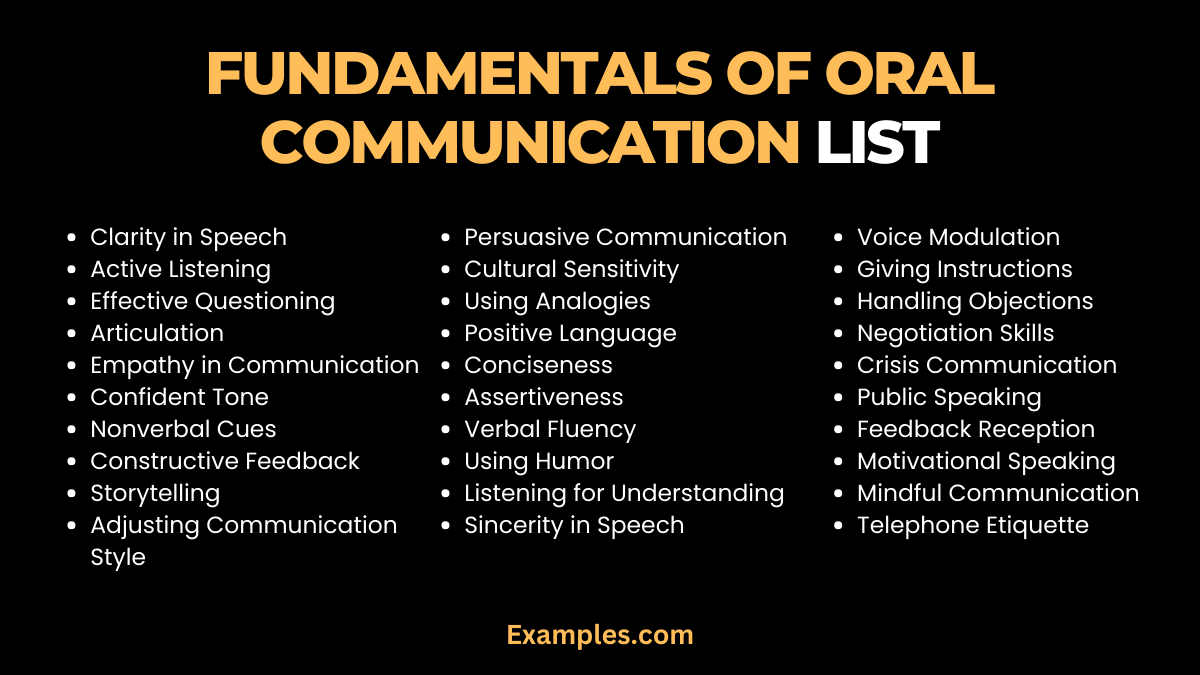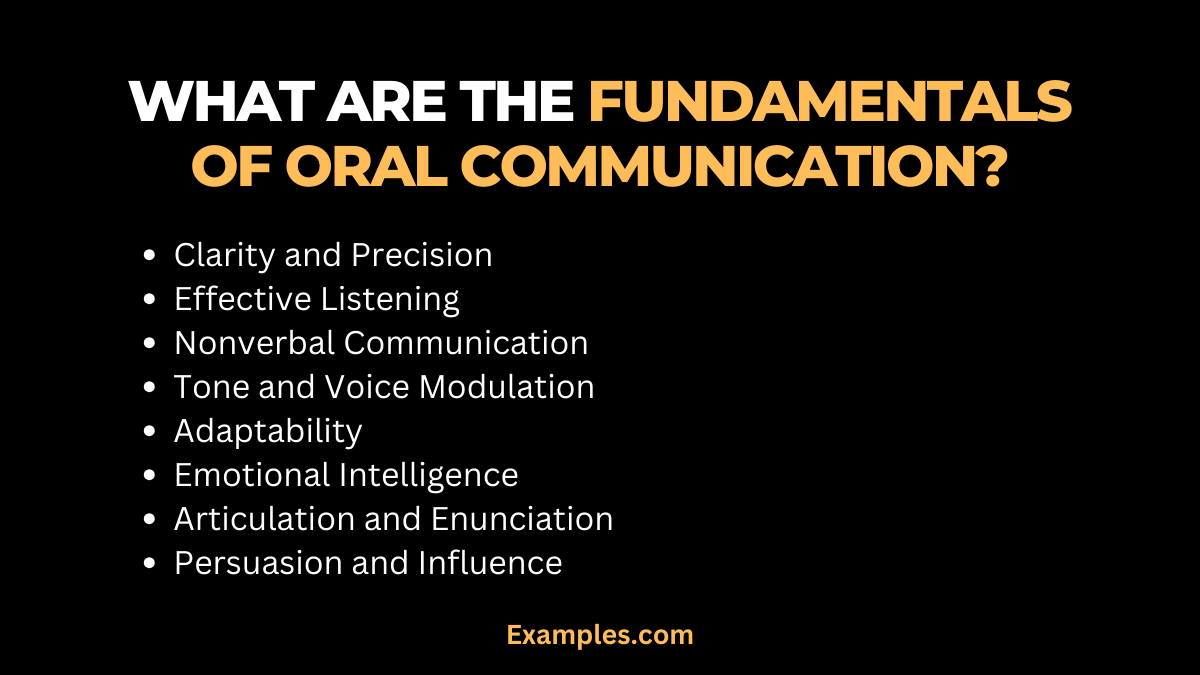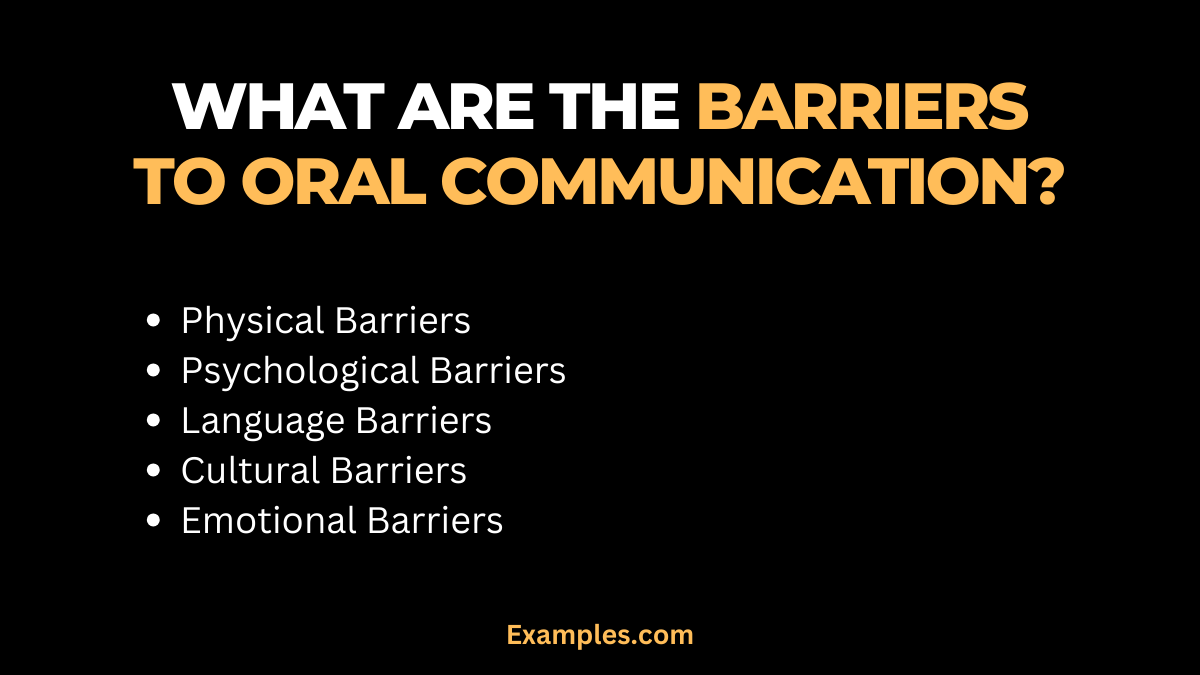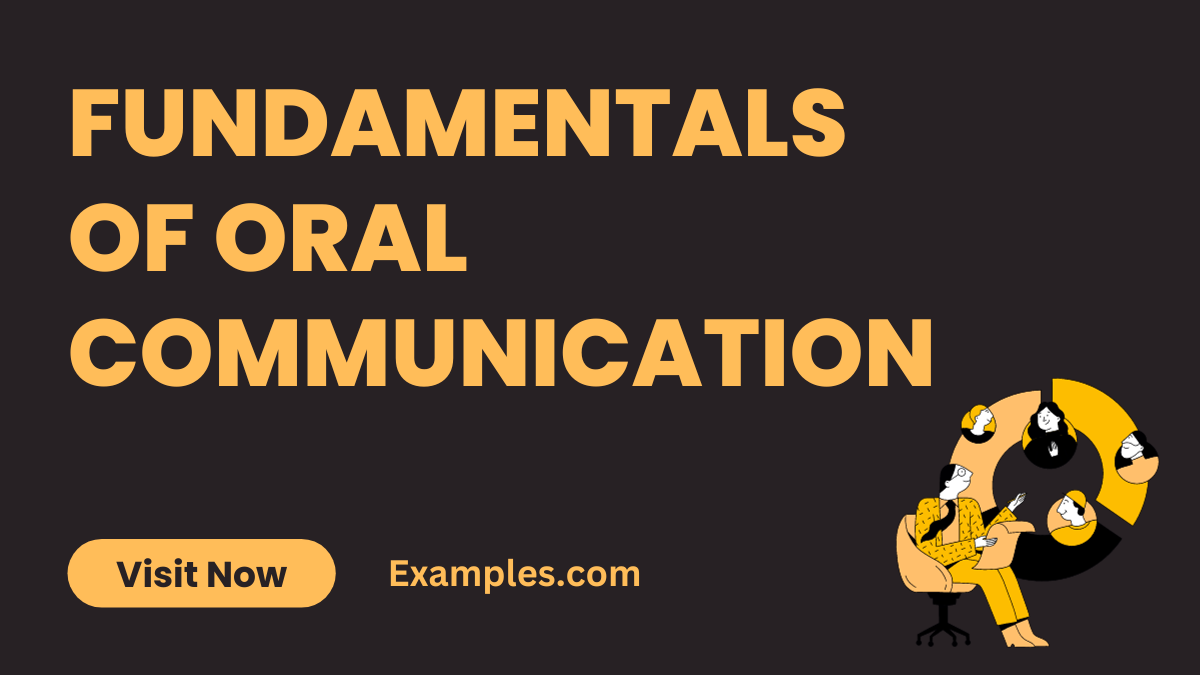Fundamentals of Oral Communication
Oral communication is an essential aspect of human interaction, and mastering its fundamentals is key to effective exchange. This comprehensive guide explores the core principles of oral communication, enriched with practical communication examples. Delve into the nuances of verbal and nonverbal communication, understand the importance of active listening, and learn how to articulate your thoughts clearly and persuasively. Ideal for anyone seeking to enhance their communication skills in personal, academic, or professional contexts.
30 Fundamentals of Oral Communication List

Mastering oral communication is crucial for effective interaction in various aspects of life. This list provides 30 fundamental elements of oral communication, each accompanied by a distinct example and a brief explanation. These examples highlight how to effectively utilize each fundamental in real-life scenarios, making them practical and valuable for anyone looking to improve their communication skills.
- Clarity in Speech: “Let’s focus on one task at a time to ensure quality.”
Encourages clear, unambiguous expression of ideas. - Active Listening: “I hear your concerns; let’s address them together.”
Demonstrates attentive listening and understanding. - Effective Questioning: “What specific challenges are you facing with this project?”
Uses questions to gather information and clarify understanding. - Articulation: “Our objective is to increase efficiency without compromising quality.”
Expresses ideas precisely and clearly. - Empathy in Communication: “I understand this situation is challenging for you.”
Shows understanding and consideration for others’ feelings. - Confident Tone: “I am certain that our strategy will lead to success.”
Exudes confidence through a firm and assured tone. - Nonverbal Cues: Smiling and nodding during a conversation.
Enhances verbal communication with positive body language. - Constructive Feedback: “Your report was well-written, but adding more data will strengthen it.”
Offers helpful criticism and suggestions for improvement. - Storytelling: “Let me share a success story that relates to our goal.”
Engages the audience with a narrative that illustrates a point. - Adjusting Communication Style: “For our younger audience, let’s use more visuals and interactive content.”
Adapts the communication approach based on the audience. - Persuasive Communication: “Investing in this will yield significant long-term benefits.”
Convinces others with compelling arguments. - Cultural Sensitivity: “I respect your cultural perspective on this issue.”
Acknowledges and respects cultural differences in communication. - Using Analogies: “Think of our teamwork like a well-oiled machine.”
Simplifies complex ideas using relatable comparisons. - Positive Language: “We have a great opportunity to improve here.”
Uses optimistic language to motivate and inspire. - Conciseness: “In short, we need to increase our marketing efforts.”
Communicates essential information without unnecessary details. - Assertiveness: “I firmly believe that this is the best course of action.”
Communicates viewpoints confidently without being aggressive. - Verbal Fluency: Speaking smoothly and fluently during a presentation.
Demonstrates the ability to speak effortlessly and coherently. - Using Humor: “To lighten the mood, here’s a funny take on our situation.”
Incorporates appropriate humor to engage the audience. - Listening for Understanding: “So, what you’re saying is…”
Confirms understanding by paraphrasing or summarizing the speaker’s points. - Sincerity in Speech: “I genuinely care about your well-being and progress.”
Expresses genuine concern and honesty in communication. - Voice Modulation: Adjusting tone and volume to emphasize key points.
Enhances the impact of the message through voice variations. - Giving Instructions: “First, complete the report, then start on the analysis.”
Provides clear and sequential directions. - Handling Objections: “I understand your concerns, let’s explore alternative solutions.”
Addresses and counters objections effectively. - Negotiation Skills: “Let’s find a middle ground that benefits both parties.”
Uses negotiation techniques to reach mutual agreements. - Crisis Communication: “During this crisis, our priority is to ensure everyone’s safety.”
Communicates effectively under pressure or during emergencies. - Public Speaking: Delivering a speech with confidence and clarity at an event.
Demonstrates effective communication in front of a large audience. - Feedback Reception: “Thank you for the feedback; I’ll work on those areas.”
Shows openness to receiving and acting on feedback. - Motivational Speaking: “Your potential is limitless; let’s harness it together.”
Inspires and motivates others through encouraging words. - Mindful Communication: “Let’s discuss this when we’re both calm and focused.”
Promotes thoughtful and considerate exchange of ideas. - Telephone Etiquette: “Thank you for calling; how may I assist you today?”
Demonstrates polite and effective communication over the phone.
What are the Fundamentals of Oral Communication?

Oral communication is an essential component of daily interactions, whether personal or professional. Understanding its fundamentals is key to enhancing overall communication effectiveness.
Clarity and Precision
- Clear Expression: The ability to convey thoughts and information in a straightforward, understandable manner.
- Precise Language: Using specific and accurate language to avoid confusion or misinterpretation.
Effective Listening
- Active Listening: Engaging with the speaker by paying full attention, understanding their message, and responding thoughtfully.
- Feedback: Providing constructive feedback or asking clarifying questions to ensure mutual understanding.
Nonverbal Communication
- Body Language: Utilizing facial expressions, gestures, and posture to supplement or reinforce spoken words.
- Eye Contact: Maintaining appropriate eye contact to build rapport and show engagement.
Tone and Voice Modulation
- Tone of Voice: Using various tones to convey different emotions or emphasize certain points.
- Volume and Pitch: Adjusting the loudness and pitch of the voice to suit the context and audience.
Adaptability
- Contextual Adaptation: Tailoring communication style to suit different situations, audiences, or environments.
- Cultural Sensitivity: Being aware of and respecting cultural differences in communication styles.
Emotional Intelligence
- Empathy: Demonstrating understanding and sensitivity to the emotions and perspectives of others.
- Self-awareness: Being aware of one’s own emotions and how they affect communication.
Articulation and Enunciation
- Clear Articulation: Pronouncing words correctly to ensure clear understanding.
- Proper Enunciation: Speaking distinctly, without mumbling or slurring words.
Persuasion and Influence
- Persuasive Techniques: Using rhetoric and persuasive strategies to influence or convince others.
- Argumentation Skills: Presenting arguments logically and coherently to support a point of view.
Understanding and practicing these fundamentals of oral communication can significantly improve the quality of interactions in various spheres of life, from personal conversations to professional discourse.
What Are the Principles of Oral Communication?
Understanding the principles of oral communication is essential for conveying messages effectively and fostering meaningful interactions.
Clarity and Simplicity
- Clear Messaging: Ensure that your speech is clear and understandable.
- Simple Language: Use straightforward language to avoid confusion.
Consistency and Coherence
- Logical Flow: Your ideas should follow a logical sequence.
- Message Consistency: Maintain consistency in your messages to avoid contradictions.
Relevance and Purpose
- Contextual Relevance: Tailor your communication to the context and purpose.
- Goal-Oriented Speech: Align your communication with the intended outcome.
Active Listening
- Engaged Listening: Pay full attention to the speaker.
- Reflective Listening: Reflect back what you’ve heard for clarity.
Empathy and Rapport
- Empathetic Understanding: Show understanding and empathy in your responses.
- Building Rapport: Establish a connection with your audience.
Feedback Incorporation
- Seek Feedback: Actively seek and incorporate feedback into your communication.
- Adaptability: Be open to modifying your approach based on the feedback received.
How are Fundamentals Used in Oral Communication?
Understanding and utilizing the fundamentals of oral communication is crucial for effective speaking and listening. These fundamentals serve as the building blocks for clear, persuasive, and meaningful conversations.
Integrating Clarity and Articulation
- Clear Expression: Using precise language and simple words to make the message easily understandable.
- Proper Articulation: Pronouncing words distinctly to prevent miscommunication.
Implementing Active Listening and Empathy
- Engagement: Focusing intently on the speaker, showing interest in their message.
- Empathetic Responses: Acknowledging the speaker’s feelings and viewpoints to establish a connection.
Utilizing Nonverbal Communication
- Body Language: Reinforcing verbal messages with appropriate gestures and expressions.
- Eye Contact: Establishing a connection with the listener or speaker to enhance interaction.
Adapting to the Audience
- Audience Awareness: Tailoring the communication style to suit the listener’s background, knowledge, and interests.
- Feedback Reception: Adjusting the message based on the audience’s responses and feedback.
What Are the Steps of Effective Oral Communication?

Effective oral communication is a process that involves several key steps. Following these steps ensures that the message is not only delivered but also received and understood as intended. Here’s a breakdown of the process:
Step 1: Planning and Preparation
- Identify the Purpose: Clearly define the goal of your communication. Whether it’s to inform, persuade, or entertain.
- Understand Your Audience: Tailor your message based on the audience’s background, interests, and level of understanding.
Step 2: Crafting the Message
- Organize Your Thoughts: Structure your message with a clear introduction, body, and conclusion.
- Choose Your Words Wisely: Use language that is appropriate for your audience and purpose.
Step 3: Delivering the Message
- Articulation and Clarity: Speak clearly and pronounce words correctly.
- Voice Modulation: Use variations in tone, pitch, and volume to emphasize key points.
Step 4: Using Nonverbal Cues
- Body Language: Utilize gestures, facial expressions, and posture to reinforce your verbal message.
- Eye Contact: Maintain appropriate eye contact to engage with your audience and build trust.
Step 5: Active Listening and Feedback
- Encourage Feedback: Invite your audience to ask questions or share their thoughts.
- Active Listening: Pay attention to feedback and respond appropriately to ensure mutual understanding.
Step 6: Reflecting and Adjusting
- Self-Reflection: After the communication, reflect on what went well and what could be improved.
- Adaptation: Be willing to adapt your communication style based on the feedback and the effectiveness of your message.
By following these steps, you can enhance your oral communication skills, ensuring that your messages are conveyed effectively and serve their intended purpose. This process is crucial for successful interactions in both personal and professional settings.
What are the Barriers to Oral Communication?

Understanding and overcoming barriers in oral communication is essential for effective interaction. Several factors can hinder the clarity and effectiveness of spoken communication.
Physical Barriers
- Environmental Noise: Background noise that disrupts the flow of conversation.
- Distance and Space: Physical distance can affect the clarity of speech and attentiveness.
Psychological Barriers
- Stress and Anxiety: Personal stress or anxiety can impede the ability to communicate effectively.
- Prejudices and Biases: Preconceived notions can lead to misinterpretation or disregard of the spoken message.
Language Barriers
- Vocabulary Differences: Lack of understanding of specific words or jargon used.
- Accent and Pronunciation: Difficulty in understanding due to different accents or pronunciation.
Cultural Barriers
- Cultural Differences: Variations in communication styles and norms across cultures.
- Nonverbal Misinterpretations: Misunderstanding nonverbal cues due to cultural differences.
Emotional Barriers
- Emotional Distress: Strong emotions like anger or sadness can hinder clear communication.
- Lack of Interest or Engagement: Disinterest can lead to poor listening and misunderstandings.
How to Improve Oral Communication Skills?
Enhancing oral communication skills involves addressing various aspects of speaking and listening.
Practice Clear and Concise Speaking
- Articulate Clearly: Focus on pronouncing words clearly.
- Be Concise: Avoid unnecessary details to keep the message clear.
Develop Active Listening Skills
- Listen Attentively: Pay full attention to the speaker without interruptions.
- Feedback for Clarity: Provide feedback or ask for clarification to ensure understanding.
Enhance Nonverbal Communication
- Positive Body Language: Use gestures and facial expressions that align with the spoken message.
- Maintain Eye Contact: Eye contact builds trust and shows engagement.
Manage Emotional Expression
- Emotional Control: Be aware of and manage your emotions during communication.
- Empathy: Understand and acknowledge the feelings of others.
Expand Vocabulary and Language Skills
- Learn New Words: Regularly incorporate new vocabulary into your speech.
- Language Practice: Practice different language styles and tones suitable for various settings.
Adapt to Different Contexts
- Contextual Awareness: Adjust your communication style according to the situation and audience.
- Cultural Sensitivity: Be mindful of cultural nuances in communication.
To conclude the article on “Fundamentals of Oral Communication,” it’s essential to emphasize the significance of mastering these skills for personal and professional success. Oral communication, when effectively utilized, bridges gaps, fosters understanding, and enhances interactions in various life aspects. For further insights into effective communication strategies and practices, consider exploring resources from the American Psychological Association (APA) and Harvard University’s Program on Negotiation. These platforms offer a wealth of knowledge and guidance to refine and apply oral communication competencies in diverse settings.



